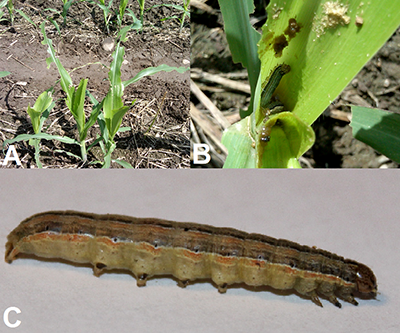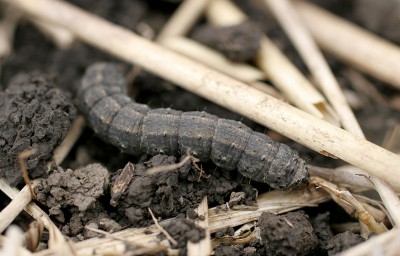May 22, 2017Pest detections cue sweet corn growers to do early-season scouting
Some pests are sporadic in nature and only become problems when conditions are right. This year’s wet spring and big storms have provided perfect conditions for black cutworm and true armyworm. The combination of weather fronts carrying moths to Michigan and wet ground delaying weed control efforts means there is a higher risk of black cutworm and true armyworm damage appearing in sweet corn fields this year.
Black cutworm can also feed on a wide range of vegetable seedlings and transplants, including tomatoes, vine crops and cole crops. Field crop growers looking for information on field corn and wheat can see Michigan State University entomologist Christina DiFonzo’s article on “Spring moth flights and infestation potential for corn and wheat.”
Determining risk
The first factor in determining if these moths may be in your area laying eggs will be your location. The spread of the moths can be patchy even if they are present in high numbers in some areas.
One way to determine if significant flights have occurred in your area is to trap pests yourself or keep tabs on traps kept by others. MSU Extension educators working in field and vegetable crops have been trapping for both pests across Michigan this spring; some wheat producers in Michigan also trap for true armyworm. Trapping tells you when there have been “intensive captures,” which means there are enough moths captured to warrant scouting at a later date. After the intensive capture, degree-days are used to predict when larvae will potentially be out causing damage in fields. The dates below represent sizeable captures of moths in bucket traps monitored by Extension educators from around Michigan.
| Dates of large captures of black cutworm and true armyworm across Michigan | ||
|---|---|---|
| County | Black cutworm | True armyworm |
| Isabella | 4/28-5/1, 5/2-5/3 | Caught but not high numbers |
| Lenawee | 4/26-4/28, 4/29-5/1, 5/1-5/2 | Data not available |
| Montcalm | Data not available | 4/20 |
| Monroe | Data not available | 4/26-4/28 |
| Oceana | Low captures | 4/25-4/27 |
If there are no trapping efforts nearby, a good tool for black cutworm is Insect Forecast, which predicts insects flights based on the weather. There have been moths in my traps during periods the weather model has suggested there would be flights, though without the trap on the ground it is hard to know the intensity of moth flights in your area.
If there is reason to believe major black cutworm or true armyworm flights have occurred in your area, the next step is evaluating the risk based on your specific location and cultural practices. Black cutworm is most likely to cause significant injury in fields with reduced tillage practices and where large populations of broadleaf weeds are present prior to planting. True armyworm infestations are most likely to be seen in no-till corn planted into grass and in corn that borders mature wheat. They also are more common in fields that border cereal grains, grassy ditches and orchard floors.
You may have already invested in black cutworm protection when purchasing seed. If you are growing Bt corn, protection may or may not be provided in the variety. Double check to see what pests the variety you are growing provides protection from. Field corn growers can refer to Difonzo’s Handy Bt Trait Table. In sweet corn, varieties that express the Vip3A trait may provide protection. Even in Bt corn, damage may still appear as the plant has to be fed on for the Bt to work. Some seed treatments also provide protection from black cutworm, for example seeds treated with Thiamethoxam may provide suppression.
Scouting and thresholds
If you believe there have been flights in your area and your sweet corn is at risk, do some scouting. Scouting for damage should begin after eggs hatch and then weekly until sweet corn grows beyond the stages most susceptible to damage from each pest (given below). Degree-days can be used in combination with trapping to help determine when to start scouting and what development stage the larvae are in.
To use degree-days in your area, find your local MSU Enviroweather station, click degree-day calculations for region, then select your start date as the date of an intensive capture in your area. This will give you multiple columns—use the degree-day (base 50 degrees Fahrenheit) to get the current degree-day accumulation in your area, as well as the forecasted degree-days over the next couple of days. This will give you an idea of what part of their life cycle both pests are currently in.
| Early season sweet corn pest development based on degree-days (base 50 F) | ||
|---|---|---|
| Pest development stage | Black cutworm1 | True armyworm2 |
| Intensive flight/egg laying | 0 | 0 |
| Egg hatching | 90 | ~113 |
| Young larvae feeding (instar 1-3) | 91-311 | Data not available |
| Older larvae feeding (instar 4-5) | 312-430 (cutting begins) | ~612 |
| Larval feeding slows (6th instar) | 431-640 | Data not available |
| Pupation/damage stops | 641 | ~909 |
1Predicting black cutworm development: Degree-days, University of Minnesota.
2 Some effects of temperature on the immature stages of the armyworm. Pseudaletia unipuncta (Lepidoptera: Noctuidae), under controlled conditions, Canada Department of Agriculture.


A-B. Black cutworm damage by young larvae begins with feeding on all parts of the leaf. This can range from small pinholes to large holes throughout the leaf. C. Once black cutworm larvae reach the later instars, they begin cutting the plants off at the base. They will curl into a characteristic C-shape when disturbed. Photos by (A-B) Kelly Estes, Illinois Natural History Survey and (C) W.M. Hantsbarger, Bugwood.org.
According to “Sweet Corn Pest Identification and Management” by the Great Lakes Vegetable Working Group and North Central Integrated Pest Management Center, for black cutworm inspect 100 plants in three locations at least weekly in fields where sweet corn has six leaves or less. Injury can range from seemingly random feeding throughout the leaf to plants being cut at the base and pulled underground. When these types of injury are present, dig around at the plant base to find the larvae who caused the damage.
Note: If larvae are small (less than 0.5 inch) or large (greater than 0.5 inch), treat for black cutworm damage if small larvae caused 3 percent stand loss or if large larvae caused 5 percent stand loss.


A. True armyworm damage is usually seen on leaf edges, which appear ragged due to feeding. B. Closer inspection of the plant will reveal true armyworm larvae hiding in the leaf whorl. C. True armyworm caterpillars can range in size from 0.15 to 1.33 inches. They have vertical stripes running down their back and sides, as well as a head capsule with a mottled yellow appearance. The key feature for identification are the black bars above each of the back legs. Photos by Fred Springborn, MSU Extension.
According to “Sweet Corn Pest Identification and Management” for true armyworm inspect 20 sweet corn plants in five locations per field at least weekly as long as plants are in the seedling and early whorl stages. True armyworm feeds on leaf edges and likes to hide in the leaf whorl during the day. Treat if more than 35 percent of the plants you scout are infested. Scout again in three days if 10-35 percent of plants are infested.
Treatment
Treatment for these pests shouldn’t be made unless scouting has occurred—they are patchy enough in distribution where you should always verify larvae are present in your field. Both pests are relatively easy to control if they are detected early, but the bigger the larvae causing the damage, the harder treatment will become. Pyrethroid insecticides are economical and effective for conventional growers, and Bt can provide organic growers control when the larvae are small.
Marissa Schuh, Michigan State University Extension















